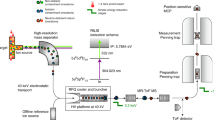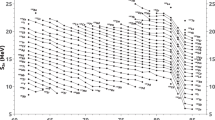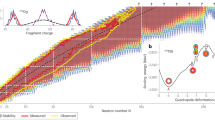Abstract
The mass of an atom incorporates all its constituents and their interactions1. The difference between the mass of an atom and the sum of its building blocks (the binding energy) is a manifestation of Einstein’s famous relation E = mc2. The binding energy determines the energy available for nuclear reactions and decays (and thus the creation of elements by stellar nucleosynthesis), and holds the key to the fundamental question of how heavy the elements can be. Superheavy elements have been observed in challenging production experiments2,3,4, but our present knowledge of the binding energy of these nuclides is based only on the detection of their decay products. The reconstruction from extended decay chains introduces uncertainties that render the interpretation difficult. Here we report direct mass measurements of trans-uranium nuclides. Located at the farthest tip of the actinide species on the proton number–neutron number diagram, these nuclides represent the gateway to the predicted island of stability. In particular, we have determined the mass values of 252-254No (atomic number 102) with the Penning trap mass spectrometer SHIPTRAP5. The uncertainties are of the order of 10 keV/c2 (representing a relative precision of 0.05 p.p.m.), despite minute production rates of less than one atom per second. Our experiments advance direct mass measurements by ten atomic numbers with no loss in accuracy, and provide reliable anchor points en route to the island of stability.
This is a preview of subscription content, access via your institution
Access options
Subscribe to this journal
Receive 51 print issues and online access
$199.00 per year
only $3.90 per issue
Buy this article
- Purchase on Springer Link
- Instant access to full article PDF
Prices may be subject to local taxes which are calculated during checkout



Similar content being viewed by others
References
Lunney, D., Pearson, J. M. & Thibault, C. Recent trends in the determination of nuclear masses. Rev. Mod. Phys. 75, 1021–1082 (2003)
Hofmann, S. & Münzenberg, G. The discovery of the heaviest elements. Rev. Mod. Phys. 72, 733–767 (2000)
Morita, K. et al. Experiment on the synthesis of element 113 in the reaction 209Bi(70Zn, n)278113. J. Phys. Soc. Jpn 73, 2593–2596 (2004)
Oganessian Heaviest nuclei from 48Ca-induced reactions. J. Phys. G 34, R165–R242 (2007)
Block, M. et al. Towards direct mass measurements of nobelium at SHIPTRAP. Eur. Phys. J. D 45, 39–45 (2007)
Moeller, P. & Nix, J. R. Stability of heavy and superheavy elements. J. Phys. G 20, 1681–1747 (1994)
Bender, M., Rutz, K., Reinhard, P.-G., Maruhn, J. A. & Greiner, W. Shell structure of superheavy nuclei in self-consistent mean-field models. Phys. Rev. C 60, 034304 (1999)
Cwiok, S., Heenen, P.-H. & Nazarewicz, W. Shape coexistence and triaxiality in the superheavy nuclei. Nature 433, 705–709 (2005)
Rainville, S. et al. A direct test of E = mc2 . Nature 438, 1096–1097 (2005)
Bollen, G. et al. Experiments with thermalized rare isotope beams from projectile fragmentation: a precision mass measurement of the superallowed β emitter 38Ca. Phys. Rev. Lett. 96, 152501 (2006)
Odom, B., Hanneke, D., D'Urso, B. & Gabrielse, G. New measurement of the electron magnetic moment using a one-electron quantum cyclotron. Phys. Rev. Lett. 97, 030801 (2006)
Blaum, K. High-accuracy mass spectrometry with stored ions. Phys. Rep. 425, 1–78 (2006)
Schweikhard, L. & Bollen, G. eds. Special issue on ultra-accurate mass determination and related topics. Int. J. Mass Spectrom. 251 (2–3) 85–312 (2006)
Roosbroeck, J. V. et al. Unambiguous identification of three β-decaying isomers in 70Cu. Phys. Rev. Lett. 92, 112501 (2005)
Block, M. et al. Discovery of a nuclear isomer in 65Fe with Penning trap mass spectrometry. Phys. Rev. Lett. 100, 132501 (2008)
Neidherr, D. et al. Discovery of 229Rn and the structure of the heaviest Rn and Ra isotopes from Penning-trap mass measurements. Phys. Rev. Lett. 102, 112501 (2009)
Martín, A. et al. Mass measurements of neutron-deficient radionuclides near the end-point of the rp-process with SHIPTRAP. Eur. Phys. A 34, 341–348 (2007)
Weber, C. et al. Mass measurements in the vicinity of the rp-process and the νp-process paths with the Penning trap facilities JYFLTRAP and SHIPTRAP. Phys. Rev. C 78, 054310 (2008)
Rauth, C. et al. First Penning trap mass measurements beyond the proton drip line. Phys. Rev. Lett. 100, 012501 (2008)
Bollen, G., Moore, R. B., Savard, G. & Stolzenberg, H. The accuracy of heavy-ion mass measurements using time of flight-ion cyclotron resonance in a Penning trap. J. Appl. Phys. 68, 4355–4374 (1990)
Chaudhuri, A. et al. Carbon-cluster mass calibration at SHIPTRAP. Eur. Phys. D 45, 47–53 (2007)
Audi, G., Wapstra, A. H. & Thibault, C. The AME2003 atomic mass evaluation. Nucl. Phys. A 729, 337–676 (2003)
Herzberg, R.-D. et al. Nuclear isomers in superheavy elements as stepping stones towards the island of stability. Nature 442, 896–899 (2006)
Hessberger, F. P. et al. Nuclear structure investigations in the region of superheavy nuclei. Phys. At. Nucl. 70, 1445–1451 (2007)
Sulignano, B. et al. Identification of a K isomer in 252No. Eur. Phys. J. A 33, 327–331 (2008)
Ghiorso, A. et al. Isotopes of element 102 with mass 251 to 258. Phys. Rev. Lett. 18, 401–404 (1967)
Mikheev, V. L. et al. Synthesis of isotopes of element 102 with mass numbers 254, 253, and 252. At. Energ. 22, 90–92 (1967)
Bemis, C. E. et al. Fragment-mass and kinetic-energy distributions from the spontaneous fission of 252No. Phys. Rev. C 15, 705–712 (1977)
Hessberger, F. P. et al. GSI experiments on synthesis and nuclear structure investigations of the heaviest nuclei. Eur. Phys. J. D 45, 33–37 (2007)
Kaneko, K. et al. Shell gaps and pn pairing interaction in N = Z nuclei. Phys. Lett. B 671, 42–45 (2009)
Acknowledgements
We thank D. Lunney for help with the preparation of the manuscript. The project was supported in part by the German Federal Ministry of Education and Research, the Max-Planck Society, and the Helmholtz Association. D.R. acknowledges support from Junta de Andalucia.
Author Contributions M.B. and M.D. performed the data analysis. M.B., K.B. and L.S. prepared the manuscript. All authors helped to perform the experiment, discussed the results, and commented on the manuscript at all stages.
Author information
Authors and Affiliations
Corresponding author
Ethics declarations
Competing interests
The authors declare no competing financial interests.
Rights and permissions
About this article
Cite this article
Block, M., Ackermann, D., Blaum, K. et al. Direct mass measurements above uranium bridge the gap to the island of stability. Nature 463, 785–788 (2010). https://doi.org/10.1038/nature08774
Received:
Accepted:
Issue Date:
DOI: https://doi.org/10.1038/nature08774
This article is cited by
-
Recent progress in experiments on the heaviest nuclides at SHIP
La Rivista del Nuovo Cimento (2022)
-
The periodic table and the physics that drives it
Nature Reviews Chemistry (2020)
-
Simulation studies of the laser ablation ion source at the SHIPTRAP setup
Hyperfine Interactions (2020)
-
Design and characterization of Ion sources for CHIP-TRAP
Hyperfine Interactions (2019)
-
A Single-Ion Reservoir as a High-Sensitive Sensor of Electric Signals
Scientific Reports (2017)
Comments
By submitting a comment you agree to abide by our Terms and Community Guidelines. If you find something abusive or that does not comply with our terms or guidelines please flag it as inappropriate.



